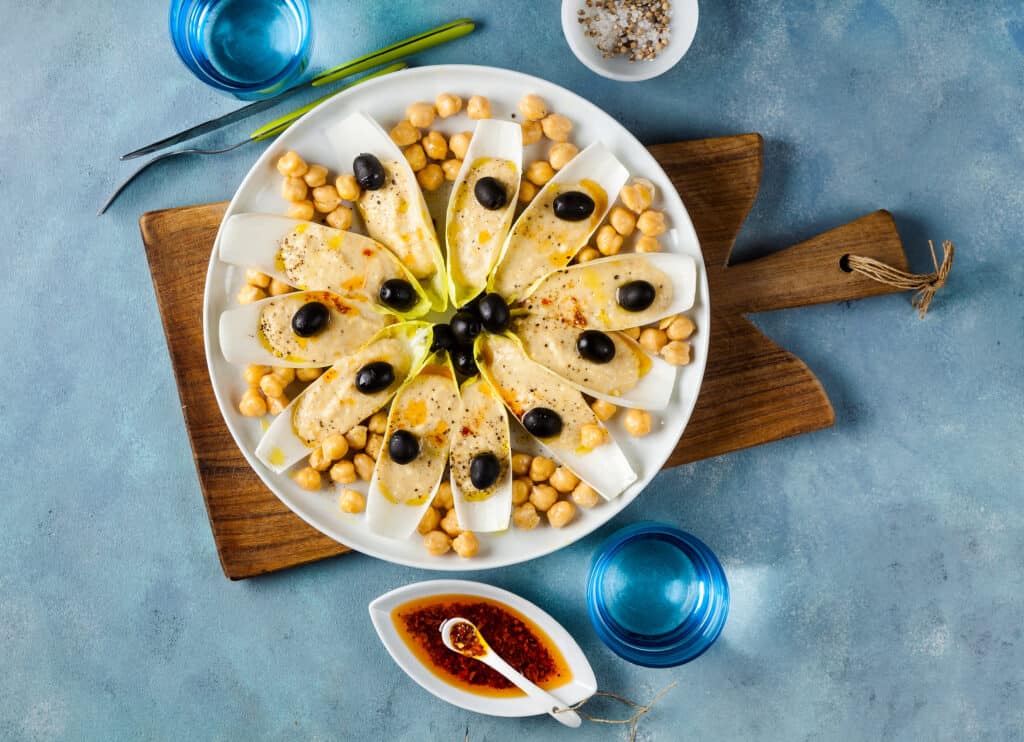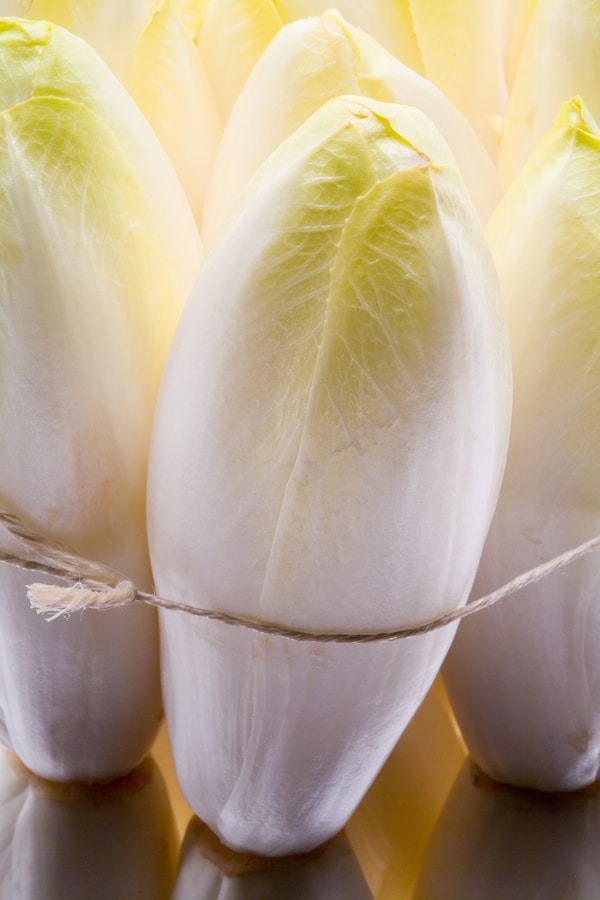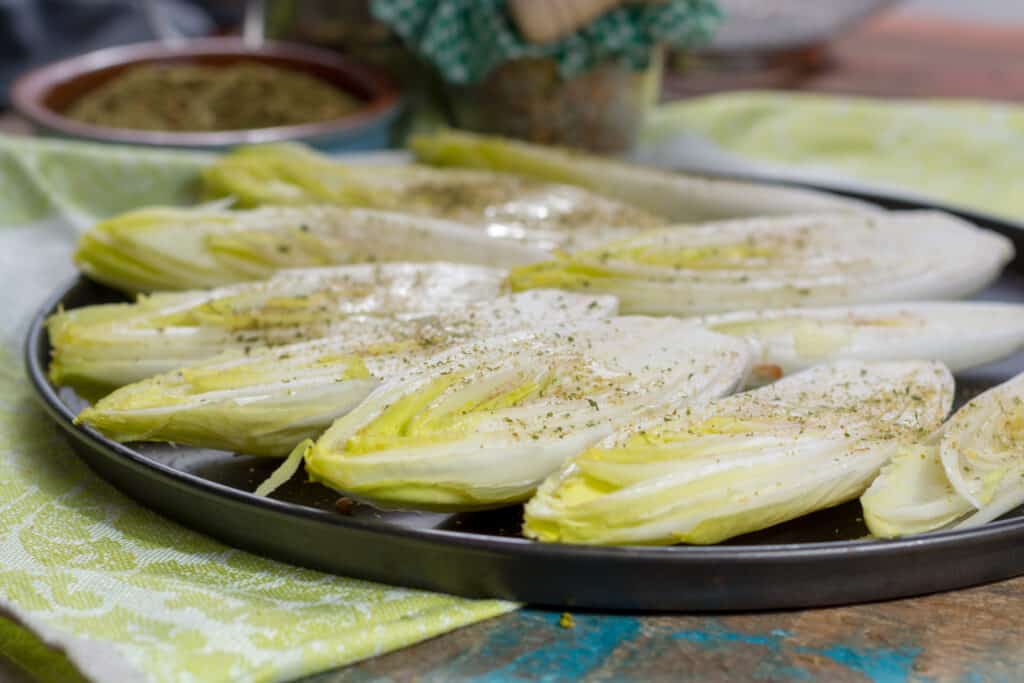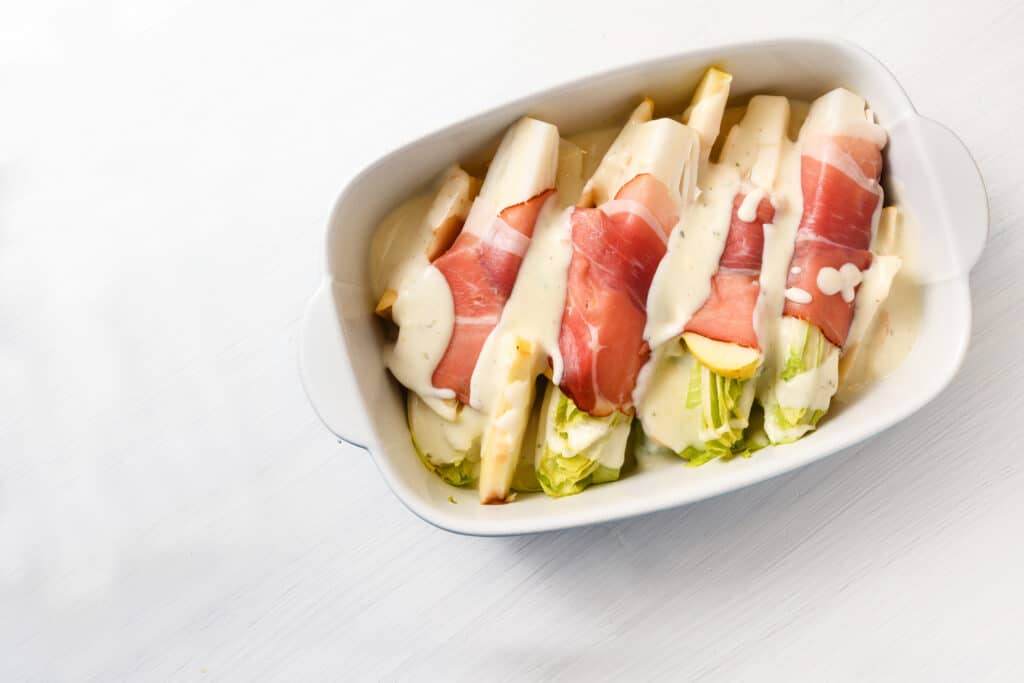Belgian endive is commonly served raw added to winter salads or braised and served with a white sauce. Belgian endive can also be steamed, parboiled, and prepared in a gratin.
The closely wrapped creamy white leaves of Belgian endive form a firm elongated, spear-shaped heart. The leaves are slightly pungent.

Belgian endive is harvested from autumn through spring.
Belgian endive is also known as French endive, witloof, chicory, and witloof chicory.

How to choose Belgian endive
- Select endive spears that are tightly closed, smooth, shiny, and swollen.
- White endive will be slightly yellow-tinged at the leaf edges.
- Leaves of red California endive will be deep red color.
- Avoid endive spears that are open, wilted, or browning at the leaf tips.
How to store Belgian endive
- Wrap endive in a damp paper towel and place it in a plastic bag in the refrigerator. It will keep for up to 5 days.

How to prep Belgian endive
- Before serving or cooking, wipe the outer leaves of the endive spear with a damp cloth. You don’t need to wash or soak the spear in water; it will make it more bitter tasting.
- Pull off and discard outer leaves; trim the base straight across; cut out about 1 inch of the cone-shaped core (it’s very bitter-tasting), then quarter or halve the heads.
Kitchen Helpers from Amazon:
- Oster Vegetable Steamer
- Chef’s Knives Set of 6
- EZ Off Jar Opener for Weak Hands
- Pepper Core Remover Stainless Steel
- Kitchen Utensils – Set of 35
Belgian endive serving suggestions
- Serve endive raw or cooked.
- Combine raw endive in salads with other greens sprinkled with vinaigrette.
- Combine raw endive with beets, apples, pears, walnuts, blue cheese, and orange or grapefruit quarters for a winter salad. (Balance the bitterness with something sweet.)
Belgian endive cooking suggestions
- Steam endive and serve with béchamel sauce or top with butter and season with herbs.
- Parboil endive then wrap each spear in ham, cover with cheese sauce, and bake.
- Braise whole or quartered white endive spears in a mixture of butter, chicken or veal stock, white wine, and a little sugar.

How to steam Belgian endive
- Steam whole or quartered.
- Add a few inches of water to a pot then insert a steamer basket. The water should not touch the bottom of the steamer basket.
- Bring the water to a simmer over medium-high heat.
- Add the endive and cover.
- Steam for 4 to 5 minutes, until tender.
How to parboil Belgian endive
- Use tongs to dip the whole endive in boiling water for about 30 seconds
- Transfer to cold water to stop the cooking.
- Dry the leaves with a kitchen towel or paper towels
How to braise Belgian endive
- Braise whole or quartered.
- Coat a large skillet with unsalted butter or olive oil.
- Add the endive and stir over medium heat until it turns light brown around the edges.
- Add salt, pepper lightly, and 1 cup of stock or white wine.
- Cover the skillet tightly and simmer until the endive is just tender about 30 minutes.
Belgian endive nutrition
- Endive is an excellent source of folic acid, potassium and contains vitamin C.
How Belgian endive is grown
- Endive is not wholly a gift of nature but a partially human invention.
- White Belgian endive starts life as wild chicory. Wild chicory—which looks something like dandelion–begins its transformation into endive in autumn when its green leaves are trimmed away and the roots are replanted in the dark so that the leaves that re-grow are blanched white. As the new leaves grow, they are forced to grow both vertically and compact as the new growth is mounded with soil, sand, or sawdust and essentially trained as a shoot.
- In several weeks, the new growth measures from 4 to 8 inches (10-20 cm) in length and 2 inches (5 cm) in diameter, and the dark green leaves and bitter taste of wild chicory are transformed into the white-leaved and mild-flavored endive.
About Belgian endive
- Belgian endive is not wholly a creation of nature. In about 1850, an observant farmer near Brussels noticed that wild chicory roots grew elongated when grown in both warmth and dark. Later, a Belgian botanist later improved upon this observation to develop a cultivation process that produced the modern shoot-like chicory called endive.
- Because wild chicory first became white endive in Belgium, it is sometimes called Belgian endive.
- Because this cultivated vegetable was first introduced to commerce at Les Halles—the famous produce market in Paris, it is sometimes called French endive.
- And because this cultivated chicory has white leaves, it is sometimes called witloof, the Flemish word that means “white leaf”.
- In recent years, a cross between Belgian endive and radicchio—red-leafed chicory—has been marketed as California red endive.
The botanical name of endive is Cichorium intybus.
Related articles:
How to Grow Chicory and Belgian Endive
How to Cook and Serve Belgian Endive
How to Plant and Grow Radicchio
How to Harvest and Store Radicchio
Four Ways to Cook and Serve Radicchio
How to Plant and Grow Endive and Escarole
Edive and Escarole Seed Starting Tips
How to Harvest and Store Endive and Escarole
Escarole and Curly Endive Serving Tips
Articles of interest:
Best Herbs for Container Growing
Garden Planning Books at Amazon:
- Vegetable Garden Almanac & Planner
- Kitchen Garden Grower’s Guide Vegetable Encyclopedia
- Vegetable Garden Grower’s Guide
- Tomato Grower’s Answer Book
More kitchen tips:
Bring your harvest to the table. Kitchen prep tips and easy recipes for the vegetables you grow. Click below for vegetable prep and recipes you can use now.
- Almonds
- Apples
- Apricot
- Aprium
- Artichoke
- Arugula
- Asparagus
- Avocado
- Bamboo Shoots
- Banana
- Basil
- Beans, Dried
- Beans. Long
- Beans, Shell
- Beans, Snap
- Beets
- Bitter Melon
- Blackberry
- Bok Choy
- Broccoli
- Broccoli Raab
- Brussels Sprouts
- Cabbage
- Cardoon
- Carrots
- Cauliflower
- Celeriac
- Celery
- Chard
- Chayote Squash
- Cherimoya
- Cherries
- Chestnut
- Chickpea
- Chinese Cabbage
- Chives
- Cilantro
- Citron
- Clementine
- Collards
- Coriander
- Corn, Sweet
- Corn, Baby
- Corn Salad, Mache
- Cranberry
- Cress
- Cucumber
- Daikon
- Dandelion
- Dill
- Eggplant
- Endive, Belgian
- Endive and Escarole
- Fava Beans
- Fig
- Florence Fennel
- Garlic
- Ginger
- Grapefruit
- Grapes
- Guava
- Horseradish
- Jerusalem Artichoke
- Jicama
- Jujube
- Kale
- Kiwifruit
- Kohlrabi
- Kumquat
- Leeks
- Lemongrass
- Lemons
- Lettuce
- Lime
- Mache (Corn Salad)
- Mandarin Orange
- Mango
- Maple Syrup
- Marjoram
- Melons
- Michihili
- Mint
- Mizuna
- Mushrooms
- Mushrooms, Cremini
- Mustard Greens
- Napa Cabbage
- Nectarine
- Okra
- Olives
- Olive oil
- Onions
- Oranges
- Oregano
- Parsley
- Parsley Root
- Parsnips
- Passion Fruit
- Pawpaw
- Peaches
- Pears
- Peas, Garden Snap
- Peas, Snow
- Pei Tsai
- Peppers, Chili
- Peppers, Sweet
- Persimmon
- Pineapple
- Pineapple Guava
- Plantain
- Plums
- Pluots
- Pomegranate
- Potatoes
- Prickly Pear
- Pumpkin
- Quince
- Radicchio
- Radishes
- Raspberries
- Rosemary
- Rhubarb
- Rutabaga
- Sage
- Salsify
- Sauerkraut
- Savory
- Shallots
- Sorrel
- Spinach
- Squash, Summer
- Squash, Winter
- Strawberries
- Sunchokes
- Sunflower
- Sweet Potato
- Swiss Chard
- Tangerine
- Taro
- Tarragon
- Thyme
- Tomatillo
- Tomato
- Turnip
- Turnip Greens
- Yams















